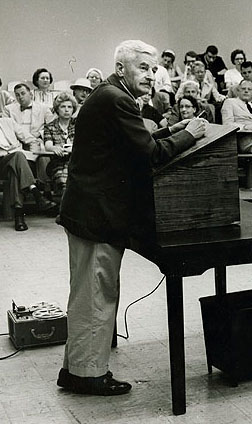Audio Clips
| CLOSE WINDOW TO RETURN TO MAP |

 Photograph by Ralph Thompson © Rector and Visitors, University of Virginia |
During the 1957 and 1958 Spring semesters, William Faulkner was the Writer-in-Residence at the University of Virginia. During that time he appeared at thirty-six different public events, reading from his work and answering over 1400 questions from students, faculty and others. Thanks to two members of the Department of English, Frederick Gwynn and Joseph Blotner, most of those sessions were recorded, and preserved on tape in the University of Virginia Special Collections Library. Over 28 hours of the recordings have been digitized, and are available online in the Faulkner at Virginia audio archive . The mp3 clips available below have been taken from that archive, and are playable on most devices. Relationship between the story and The Sound and the Fury? (15 February1957; 1:16) Why did you name the character "Jesus"? (25 February 1957; 0:48) Use of Quentin as a child narrator? (6 May 1958; 1:24) |
Relationship between the story and The Sound and the Fury? (15 February1957; 1:16)
Frederick Gwynn: I know I've got one somewhere, so if I may, I'd like to ask what you felt was the relationship between The Sound and the Fury and the short story, "That Evening Sun." Did one come before the other in some significant way?
William Faulkner: The—"That Evening Sun" must have come after The Sound and the Fury. The first time I thought of—of those children, Caddy and Jason and Quentin, was when I did The Sound and the Fury, so the other story must've come after it, though it's hard to—for me to unravel these people, to say when one came to life. It's very difficult. I myself can't distinguish one book from another sometimes. I think not of books but of characters, and I can't remember which book has which characters in it.
Why did you name the character "Jesus"? (25 February 1957; 0:48)
William Faulkner: Yes, sir.
Unidentified participant: Sir, speaking of symbolism, in your story "That Evening Sun," why did you name that fellow Jesus?
William Faulkner: That was probably a deliberate intent to shock just a little. That's a—it's a valid name among Negroes in—in Mississippi. That is, you don't see it too often, but it's—it's nothing unusual. It's not uncommon. But there may have been a little, not so much to shock but to emphasize the point I was making, which was that this—this Negro woman who had given devotion to the white family knew that when—when the crisis of her need came, the white family wouldn't be there.
Use of Quentin as a child narrator? (6 May 1958; 1:24)
Robert Kellogg: Mr. Faulkner, I'd like to ask you a question if it's not too involved along those lines. Last week we were talking about the use of dialect to differentiate the classes that people originated in, the social classes, the geographical location. I was wondering perhaps about the use of language of a child narrator. I've noticed in, say for example "That Evening Sun," lots of Quentin's sentences seem short and perhaps the way a child might speak them and yet it's pretty grown-up for a nine-year-old to report all of the things he does. I wonder whether you'd comment on his rather accurate reporting.
William Faulkner: One has to take liberties to that extent. I think that some of the things that Huck Finn recorded he couldn't have done at his age. That's the liberties which the writer must take in order to make his story clear and interesting.
Robert Kellogg: And yet we—we assume his point of view throughout the story, is that not so?
William Faulkner: Yes, that his point of view is still that of his age, even though his diction may not be.
Robert Kellogg: Yes, sir.
